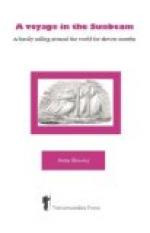About ten o’clock we went ashore again in the whale-boat, which Tom had engaged to wait on us during our stay, and made the best of our way to a warehouse to look at some ponchos, which are the speciality of this part of South America. Everybody wears one, from the beggar to the highest official. The best kind of ponchos are very expensive, being made from a particular part of the finest hair of the vicuna, hand-woven by women, in the province of Catamarca. The genuine article is difficult to get, even here. In the shops the price usually varies from 30_l_. to 80_l_.; but we were shown some at a rather lower price—from 20_l_. to 60_l_. each. They are soft as silk, perfectly waterproof, and will wear, it is said, for ever. We met a fine-looking man in one of beautiful quality yesterday. He told us that it originally cost 30_l_. in Catamarca, twenty years ago, and that he gave 20_l_. for it, second-hand, ten years ago; and, with the exception of a few slight tears, it is now as good as ever. Before we came here, we were strongly advised, in case we should happen to go on a rough expedition up country, not to be tempted to take with us any good ponchos, as the Gauchos, or half-bred Indians of the Pampas, who are great connoisseurs of these articles, and can distinguish their quality at a glance, would not hesitate to cut our throats in order to obtain possession of them.
The material of which they are made is of the closest texture, and as the hair has never been dressed or dyed it retains all its natural oil and original colour, the latter varying from a very pretty yellow fawn to a pale cream-colour. The majority of the ponchos worn here are, however, made at Manchester, of a cheap and inferior material. They look exactly like the real thing at first sight, but are neither so light nor so warm, nor do they wear at all well. Occasionally they are made of silk, but more often of bright-coloured wool. In shape a poncho is simply a square shawl with a hole in the middle for the head of the wearer. On horseback the appearance is particularly picturesque, and it forms also a convenient cloak, which comes well over the saddle, before and behind, and leaves the arms, though covered, perfectly free.
The natives, as a rule, wear a second poncho, generally of a different colour, tucked into the waistband of their long full linen drawers (calzoncillos), so as to make a pair of short baggy over-trousers. A poor man is content with a shirt, drawers, and two ponchos. A rich man has many rows of fringe and frills of lace at the bottom of his calzoncillos, and wears a short coat, with silver buttons, and a gorgeous silver belt, covered with dollars. His horse-fittings and massive stirrups (to say nothing of his enormous spurs) will be of solid silver, and his arms inlaid with the same metal. He will sometimes give as much as from 10_l_. to 20_l_. for a pair of stirrups alone, and the rest of his dress and equipment is proportionately expensive. The cost of the silver articles is little more than the value of the metal itself, which is of very pure quality, and is only roughly worked by the Indians or Gauchos. But as Manchester provides the ponchos, so does Birmingham the saddlery and fittings, especially those in use in the neighbourhood of towns.




